Building Trust on Your Team: Kayser, Lencioni, and DeGrosky
VerifiedAdded on 2022/08/21
|6
|1201
|12
Report
AI Summary
This report delves into the critical aspects of building trust within teams, drawing on the insights of Kayser, Lencioni, and DeGrosky. It emphasizes the importance of human resources in organizational success, highlighting how team members contribute their skills and talents. The report discusses how effective team management is crucial to prevent conflicts and enhance productivity. It references Maslow's hierarchy of needs and motivation theory, underscoring the need to meet employees' physiological, safety, love and belonging, esteem, and self-actualization needs. The report explores Kayser's emphasis on collaborative measures and effective communication for team building, Lencioni's focus on the absence of affection and empathy that leads to distrust, and DeGrosky's methods for arranging training programs and team building activities. It also addresses the challenges faced by geographically dispersed teams and the need for strong inter-team collaboration, providing insights into how to foster a positive working culture and improve team performance. The report concludes by emphasizing the importance of employee empowerment, satisfaction, and the role of team leaders in implementing effective strategies.
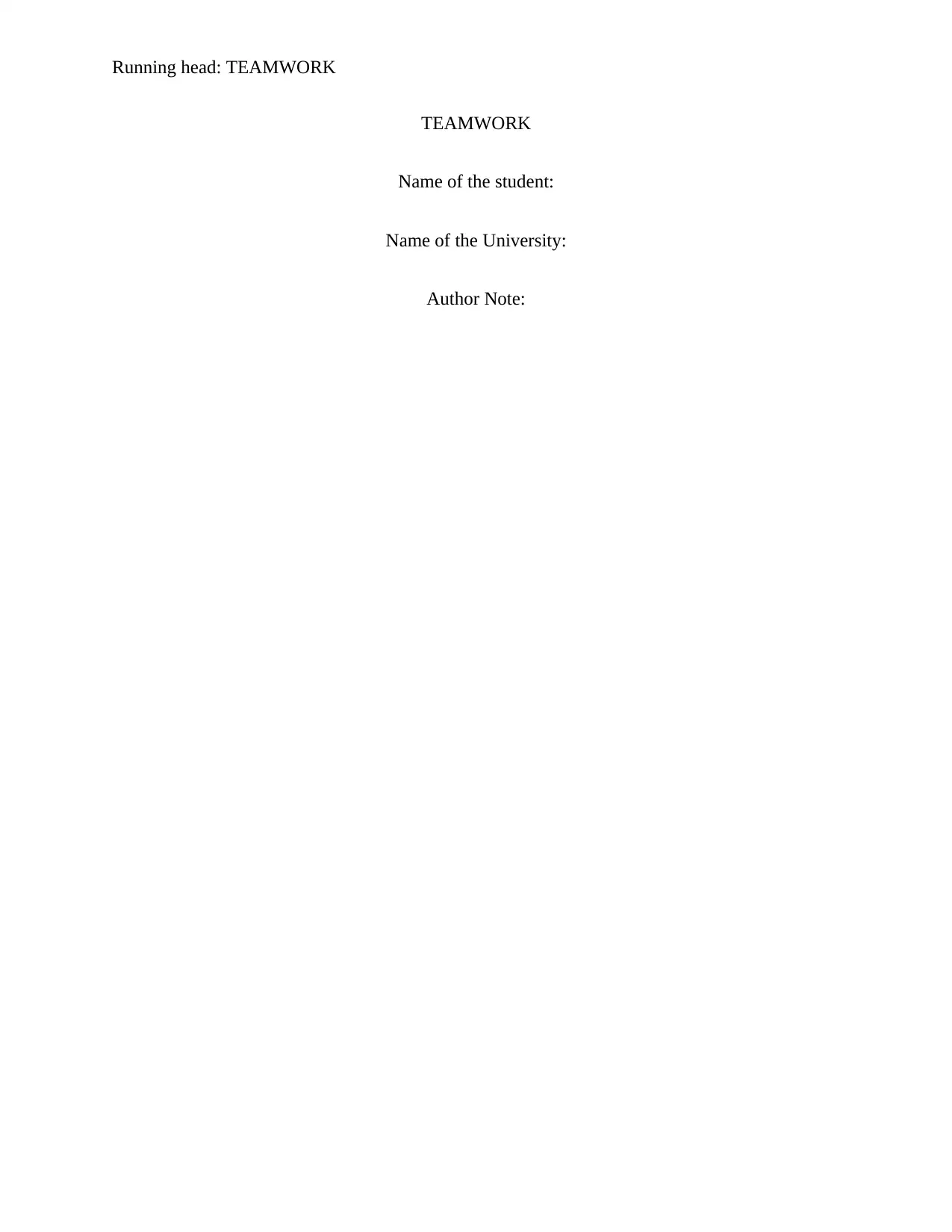
Running head: TEAMWORK
TEAMWORK
Name of the student:
Name of the University:
Author Note:
TEAMWORK
Name of the student:
Name of the University:
Author Note:
Paraphrase This Document
Need a fresh take? Get an instant paraphrase of this document with our AI Paraphraser
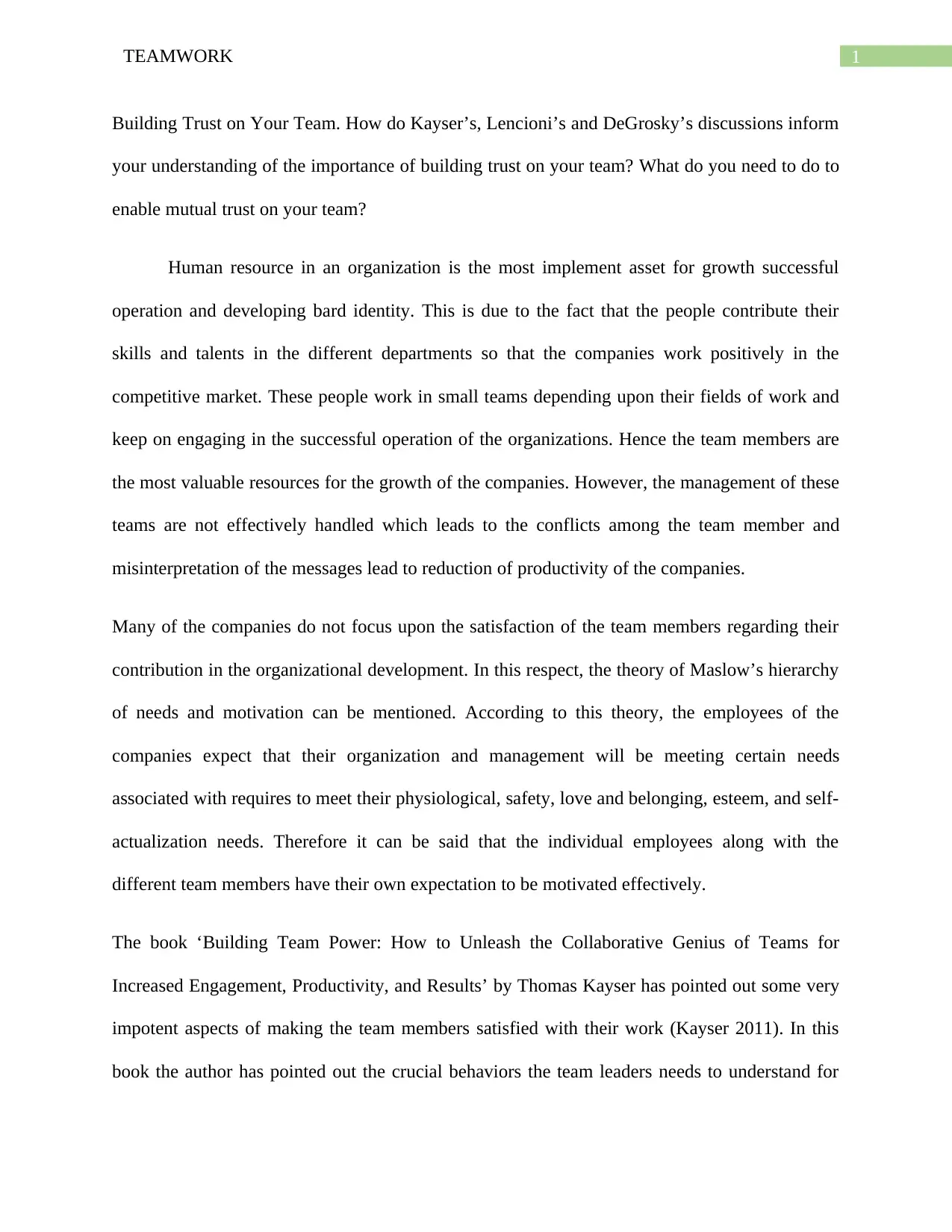
1TEAMWORK
Building Trust on Your Team. How do Kayser’s, Lencioni’s and DeGrosky’s discussions inform
your understanding of the importance of building trust on your team? What do you need to do to
enable mutual trust on your team?
Human resource in an organization is the most implement asset for growth successful
operation and developing bard identity. This is due to the fact that the people contribute their
skills and talents in the different departments so that the companies work positively in the
competitive market. These people work in small teams depending upon their fields of work and
keep on engaging in the successful operation of the organizations. Hence the team members are
the most valuable resources for the growth of the companies. However, the management of these
teams are not effectively handled which leads to the conflicts among the team member and
misinterpretation of the messages lead to reduction of productivity of the companies.
Many of the companies do not focus upon the satisfaction of the team members regarding their
contribution in the organizational development. In this respect, the theory of Maslow’s hierarchy
of needs and motivation can be mentioned. According to this theory, the employees of the
companies expect that their organization and management will be meeting certain needs
associated with requires to meet their physiological, safety, love and belonging, esteem, and self-
actualization needs. Therefore it can be said that the individual employees along with the
different team members have their own expectation to be motivated effectively.
The book ‘Building Team Power: How to Unleash the Collaborative Genius of Teams for
Increased Engagement, Productivity, and Results’ by Thomas Kayser has pointed out some very
impotent aspects of making the team members satisfied with their work (Kayser 2011). In this
book the author has pointed out the crucial behaviors the team leaders needs to understand for
Building Trust on Your Team. How do Kayser’s, Lencioni’s and DeGrosky’s discussions inform
your understanding of the importance of building trust on your team? What do you need to do to
enable mutual trust on your team?
Human resource in an organization is the most implement asset for growth successful
operation and developing bard identity. This is due to the fact that the people contribute their
skills and talents in the different departments so that the companies work positively in the
competitive market. These people work in small teams depending upon their fields of work and
keep on engaging in the successful operation of the organizations. Hence the team members are
the most valuable resources for the growth of the companies. However, the management of these
teams are not effectively handled which leads to the conflicts among the team member and
misinterpretation of the messages lead to reduction of productivity of the companies.
Many of the companies do not focus upon the satisfaction of the team members regarding their
contribution in the organizational development. In this respect, the theory of Maslow’s hierarchy
of needs and motivation can be mentioned. According to this theory, the employees of the
companies expect that their organization and management will be meeting certain needs
associated with requires to meet their physiological, safety, love and belonging, esteem, and self-
actualization needs. Therefore it can be said that the individual employees along with the
different team members have their own expectation to be motivated effectively.
The book ‘Building Team Power: How to Unleash the Collaborative Genius of Teams for
Increased Engagement, Productivity, and Results’ by Thomas Kayser has pointed out some very
impotent aspects of making the team members satisfied with their work (Kayser 2011). In this
book the author has pointed out the crucial behaviors the team leaders needs to understand for
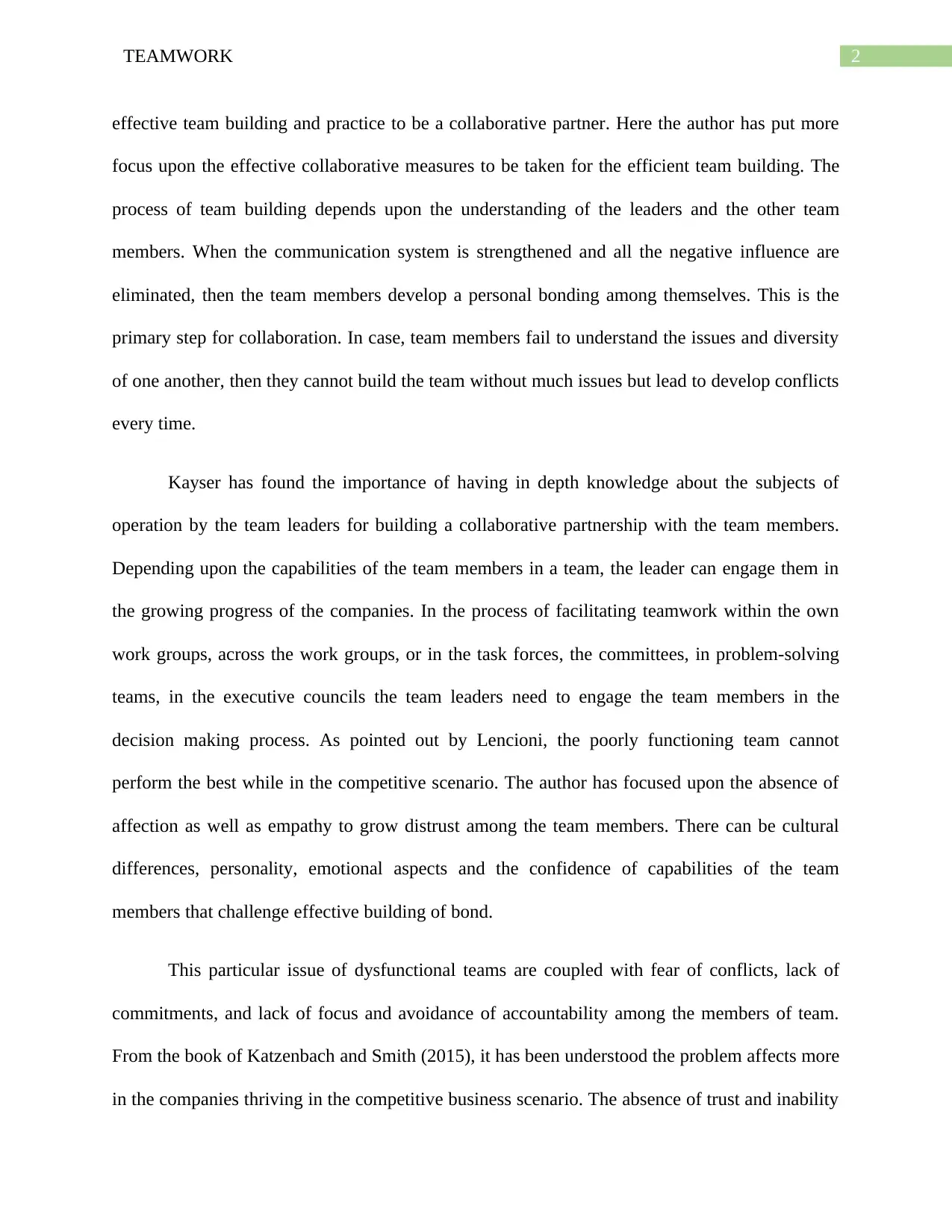
2TEAMWORK
effective team building and practice to be a collaborative partner. Here the author has put more
focus upon the effective collaborative measures to be taken for the efficient team building. The
process of team building depends upon the understanding of the leaders and the other team
members. When the communication system is strengthened and all the negative influence are
eliminated, then the team members develop a personal bonding among themselves. This is the
primary step for collaboration. In case, team members fail to understand the issues and diversity
of one another, then they cannot build the team without much issues but lead to develop conflicts
every time.
Kayser has found the importance of having in depth knowledge about the subjects of
operation by the team leaders for building a collaborative partnership with the team members.
Depending upon the capabilities of the team members in a team, the leader can engage them in
the growing progress of the companies. In the process of facilitating teamwork within the own
work groups, across the work groups, or in the task forces, the committees, in problem-solving
teams, in the executive councils the team leaders need to engage the team members in the
decision making process. As pointed out by Lencioni, the poorly functioning team cannot
perform the best while in the competitive scenario. The author has focused upon the absence of
affection as well as empathy to grow distrust among the team members. There can be cultural
differences, personality, emotional aspects and the confidence of capabilities of the team
members that challenge effective building of bond.
This particular issue of dysfunctional teams are coupled with fear of conflicts, lack of
commitments, and lack of focus and avoidance of accountability among the members of team.
From the book of Katzenbach and Smith (2015), it has been understood the problem affects more
in the companies thriving in the competitive business scenario. The absence of trust and inability
effective team building and practice to be a collaborative partner. Here the author has put more
focus upon the effective collaborative measures to be taken for the efficient team building. The
process of team building depends upon the understanding of the leaders and the other team
members. When the communication system is strengthened and all the negative influence are
eliminated, then the team members develop a personal bonding among themselves. This is the
primary step for collaboration. In case, team members fail to understand the issues and diversity
of one another, then they cannot build the team without much issues but lead to develop conflicts
every time.
Kayser has found the importance of having in depth knowledge about the subjects of
operation by the team leaders for building a collaborative partnership with the team members.
Depending upon the capabilities of the team members in a team, the leader can engage them in
the growing progress of the companies. In the process of facilitating teamwork within the own
work groups, across the work groups, or in the task forces, the committees, in problem-solving
teams, in the executive councils the team leaders need to engage the team members in the
decision making process. As pointed out by Lencioni, the poorly functioning team cannot
perform the best while in the competitive scenario. The author has focused upon the absence of
affection as well as empathy to grow distrust among the team members. There can be cultural
differences, personality, emotional aspects and the confidence of capabilities of the team
members that challenge effective building of bond.
This particular issue of dysfunctional teams are coupled with fear of conflicts, lack of
commitments, and lack of focus and avoidance of accountability among the members of team.
From the book of Katzenbach and Smith (2015), it has been understood the problem affects more
in the companies thriving in the competitive business scenario. The absence of trust and inability
⊘ This is a preview!⊘
Do you want full access?
Subscribe today to unlock all pages.

Trusted by 1+ million students worldwide
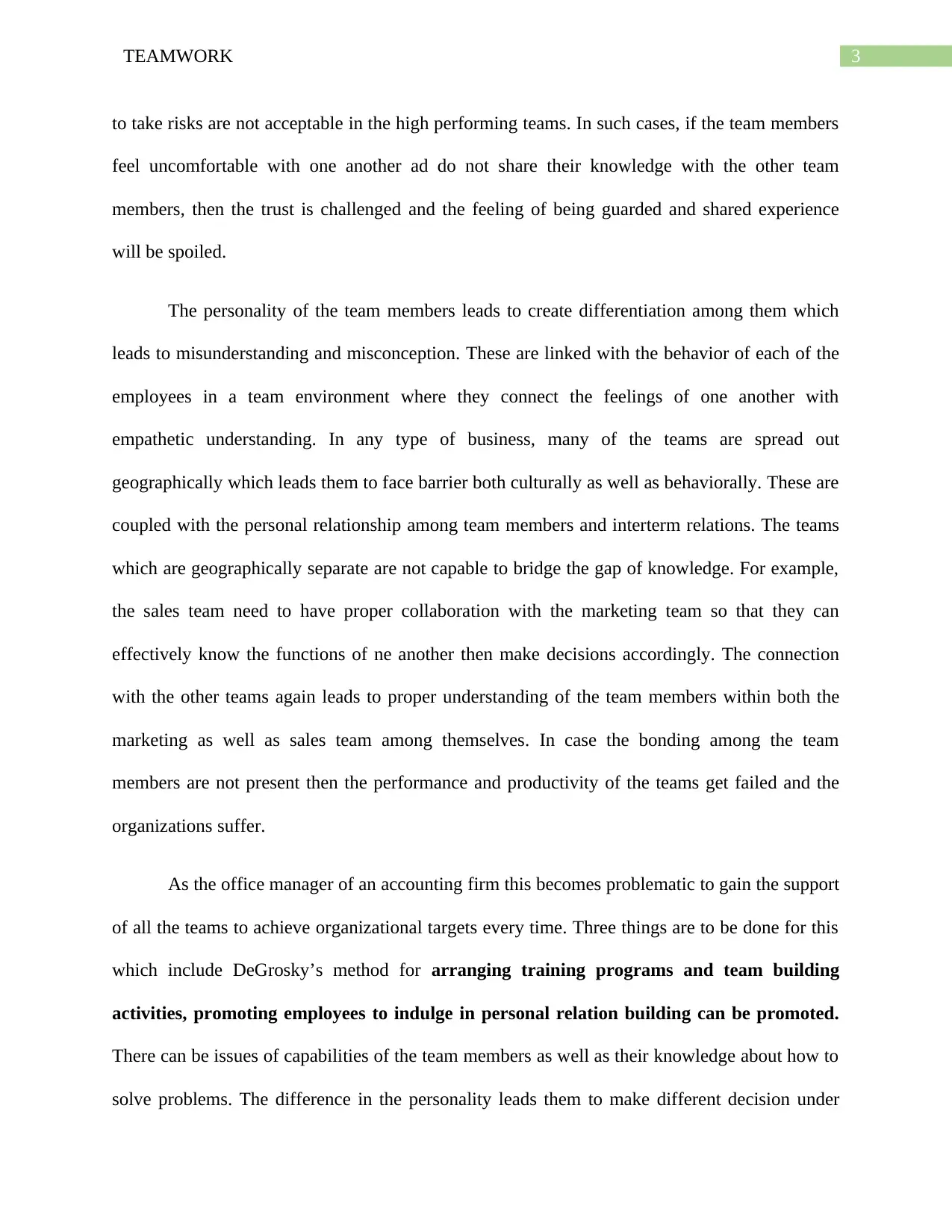
3TEAMWORK
to take risks are not acceptable in the high performing teams. In such cases, if the team members
feel uncomfortable with one another ad do not share their knowledge with the other team
members, then the trust is challenged and the feeling of being guarded and shared experience
will be spoiled.
The personality of the team members leads to create differentiation among them which
leads to misunderstanding and misconception. These are linked with the behavior of each of the
employees in a team environment where they connect the feelings of one another with
empathetic understanding. In any type of business, many of the teams are spread out
geographically which leads them to face barrier both culturally as well as behaviorally. These are
coupled with the personal relationship among team members and interterm relations. The teams
which are geographically separate are not capable to bridge the gap of knowledge. For example,
the sales team need to have proper collaboration with the marketing team so that they can
effectively know the functions of ne another then make decisions accordingly. The connection
with the other teams again leads to proper understanding of the team members within both the
marketing as well as sales team among themselves. In case the bonding among the team
members are not present then the performance and productivity of the teams get failed and the
organizations suffer.
As the office manager of an accounting firm this becomes problematic to gain the support
of all the teams to achieve organizational targets every time. Three things are to be done for this
which include DeGrosky’s method for arranging training programs and team building
activities, promoting employees to indulge in personal relation building can be promoted.
There can be issues of capabilities of the team members as well as their knowledge about how to
solve problems. The difference in the personality leads them to make different decision under
to take risks are not acceptable in the high performing teams. In such cases, if the team members
feel uncomfortable with one another ad do not share their knowledge with the other team
members, then the trust is challenged and the feeling of being guarded and shared experience
will be spoiled.
The personality of the team members leads to create differentiation among them which
leads to misunderstanding and misconception. These are linked with the behavior of each of the
employees in a team environment where they connect the feelings of one another with
empathetic understanding. In any type of business, many of the teams are spread out
geographically which leads them to face barrier both culturally as well as behaviorally. These are
coupled with the personal relationship among team members and interterm relations. The teams
which are geographically separate are not capable to bridge the gap of knowledge. For example,
the sales team need to have proper collaboration with the marketing team so that they can
effectively know the functions of ne another then make decisions accordingly. The connection
with the other teams again leads to proper understanding of the team members within both the
marketing as well as sales team among themselves. In case the bonding among the team
members are not present then the performance and productivity of the teams get failed and the
organizations suffer.
As the office manager of an accounting firm this becomes problematic to gain the support
of all the teams to achieve organizational targets every time. Three things are to be done for this
which include DeGrosky’s method for arranging training programs and team building
activities, promoting employees to indulge in personal relation building can be promoted.
There can be issues of capabilities of the team members as well as their knowledge about how to
solve problems. The difference in the personality leads them to make different decision under
Paraphrase This Document
Need a fresh take? Get an instant paraphrase of this document with our AI Paraphraser
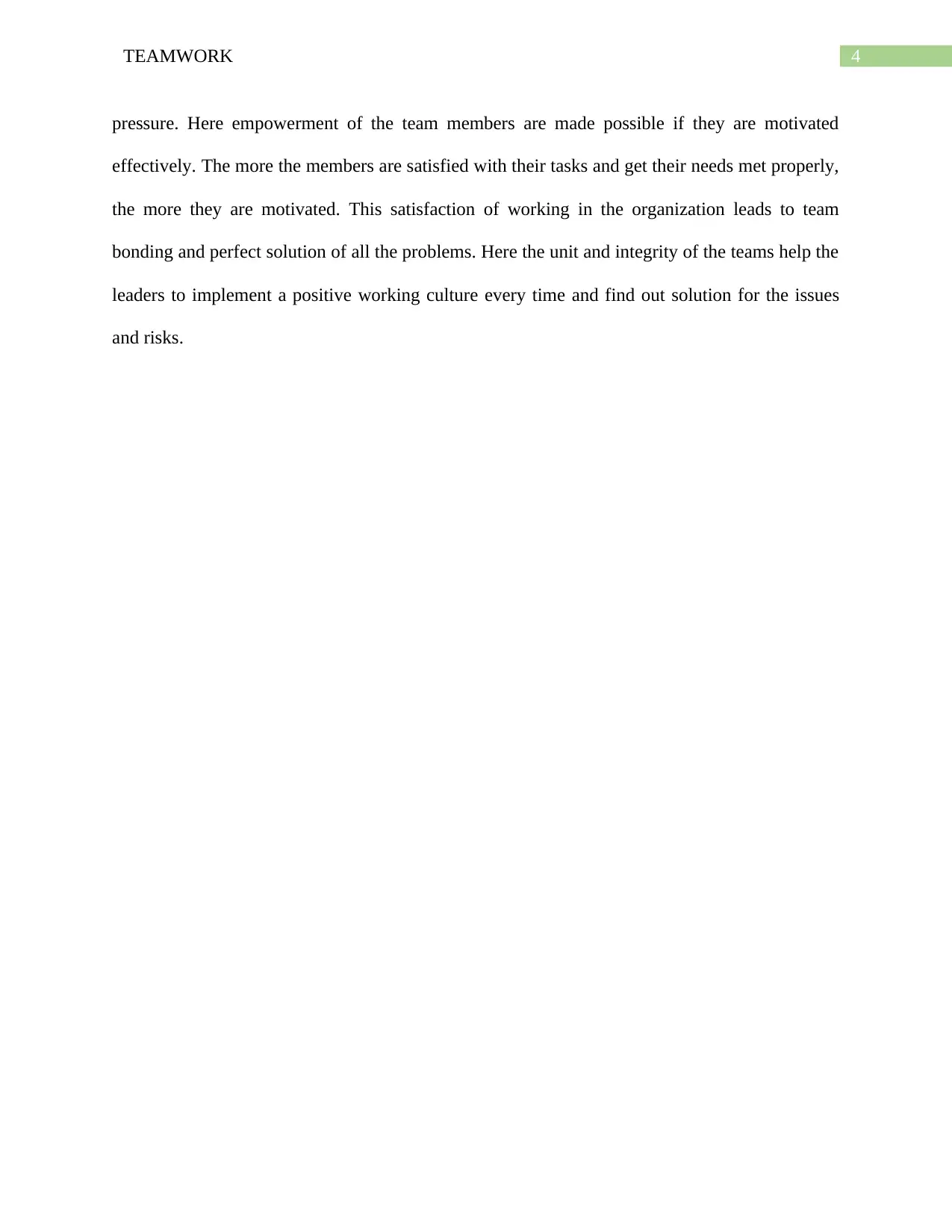
4TEAMWORK
pressure. Here empowerment of the team members are made possible if they are motivated
effectively. The more the members are satisfied with their tasks and get their needs met properly,
the more they are motivated. This satisfaction of working in the organization leads to team
bonding and perfect solution of all the problems. Here the unit and integrity of the teams help the
leaders to implement a positive working culture every time and find out solution for the issues
and risks.
pressure. Here empowerment of the team members are made possible if they are motivated
effectively. The more the members are satisfied with their tasks and get their needs met properly,
the more they are motivated. This satisfaction of working in the organization leads to team
bonding and perfect solution of all the problems. Here the unit and integrity of the teams help the
leaders to implement a positive working culture every time and find out solution for the issues
and risks.
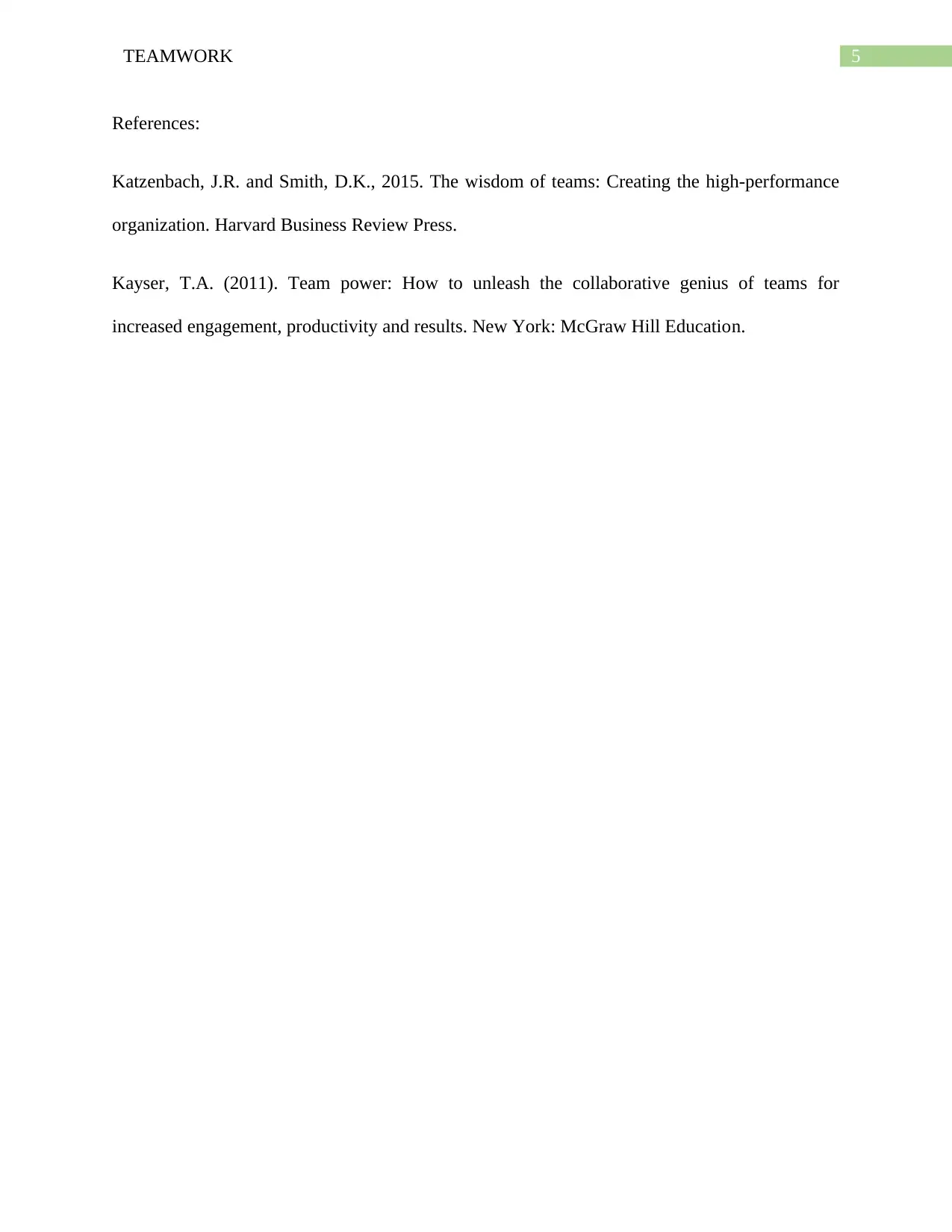
5TEAMWORK
References:
Katzenbach, J.R. and Smith, D.K., 2015. The wisdom of teams: Creating the high-performance
organization. Harvard Business Review Press.
Kayser, T.A. (2011). Team power: How to unleash the collaborative genius of teams for
increased engagement, productivity and results. New York: McGraw Hill Education.
References:
Katzenbach, J.R. and Smith, D.K., 2015. The wisdom of teams: Creating the high-performance
organization. Harvard Business Review Press.
Kayser, T.A. (2011). Team power: How to unleash the collaborative genius of teams for
increased engagement, productivity and results. New York: McGraw Hill Education.
⊘ This is a preview!⊘
Do you want full access?
Subscribe today to unlock all pages.

Trusted by 1+ million students worldwide
1 out of 6
Related Documents
Your All-in-One AI-Powered Toolkit for Academic Success.
+13062052269
info@desklib.com
Available 24*7 on WhatsApp / Email
![[object Object]](/_next/static/media/star-bottom.7253800d.svg)
Unlock your academic potential
Copyright © 2020–2025 A2Z Services. All Rights Reserved. Developed and managed by ZUCOL.





